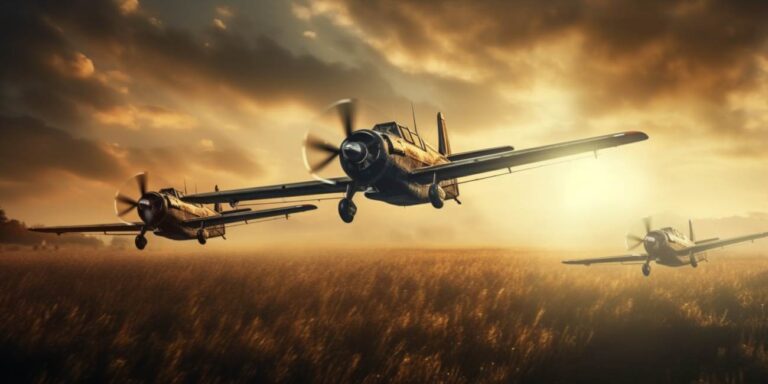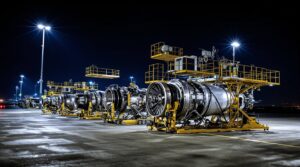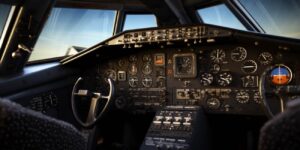At the forefront of this aerial might is the venerable C-130 Hercules, a workhorse renowned for its versatility and adaptability. This tactical airlift aircraft has been a linchpin in the US military’s logistical operations for decades. With a distinctive appearance and a storied history, the C-130 fleet forms the backbone of the Air Force’s airlift capabilities.
Another stalwart in the transport category is the C-17 Globemaster III, a strategic airlift aircraft that excels in rapid strategic delivery of troops and cargo to main operating bases or directly to forward bases in the deployment area. Its advanced design and substantial payload capacity make it a crucial asset in projecting US military power across the globe.
Adding to the list is the iconic C-5M Super Galaxy, one of the largest military aircraft globally. This colossal transport aircraft boasts an impressive cargo capacity, enabling it to carry oversized and outsized cargo that other aircraft cannot accommodate. Its strategic airlift capabilities contribute significantly to the United States’ ability to swiftly deploy forces and equipment.
For aerial refueling and cargo transport, the KC-135 Stratotanker plays a vital dual role. Originally designed as an aerial refueling tanker, it has evolved into a multi-role aircraft capable of transporting both passengers and cargo. The adaptability of the KC-135 enhances the overall flexibility of the US Air Force’s transport capabilities.
A comprehensive look at how many transport aircraft does the US have extends beyond individual models to the sheer quantity that populates its inventory. The US Air Force, Marine Corps, and Navy collectively operate a fleet that numbers in the hundreds. These aircraft, spread across different branches, work in tandem to ensure a seamless and effective transportation network.
As of the latest available data, the US Air Force alone operates a diverse fleet of over 1,100 transport aircraft, showcasing the magnitude of its aerial logistics capacity. This includes a mix of strategic and tactical airlifters, each contributing uniquely to the overall transport capabilities of the nation.
Furthermore, a glimpse into the future of US transport aircraft reveals ongoing developments and modernization efforts. Programs such as the Next-Generation Air Dominance (NGAD) project aim to introduce cutting-edge technologies and platforms, ensuring that the United States remains at the forefront of air mobility and logistical prowess.
The c-17 globemaster: reliable workhorse of us airlift capability
The C-17 Globemaster stands tall as the reliable workhorse of U.S. airlift capability. In the realm of military transport aircraft, the C-17 has earned its reputation through a combination of versatility, strategic airlift capacity, and robust performance.
One of the defining features of the C-17 is its remarkable payload capacity. Capable of carrying oversized cargo, including military vehicles, helicopters, and large equipment, this aircraft plays a pivotal role in supporting rapid deployment and sustainment of military operations. The sheer power and flexibility of the C-17 make it an indispensable asset in times of crisis and conflict.
The reliability of the C-17 is underscored by its ability to operate in diverse environments. Whether navigating through austere airfields or executing precision airdrops, the aircraft’s advanced avionics and aerodynamic design contribute to its adaptability. It’s a true testament to engineering excellence, enabling the U.S. military to respond swiftly to evolving situations.
Strategic airlift capability is not just about moving cargo; it’s about doing so with efficiency and speed. The C-17’s impressive speed and range allow it to cover vast distances without the need for refueling, making it an asset for global operations. This capability enhances the United States’ ability to project power and respond promptly to emerging threats.
When it comes to rapid deployment of troops, the C-17 is unparalleled. With the ability to carry a substantial number of personnel and their equipment, it serves as a critical tool for force projection. Whether it’s delivering troops to a conflict zone or conducting humanitarian missions, the C-17’s role in ensuring a swift and effective response is paramount.
Moreover, the C-17’s short takeoff and landing (STOL) capabilities further contribute to its operational flexibility. This feature enables the aircraft to operate from airfields that may have limited infrastructure, expanding the range of possible mission scenarios. In military operations, where access to conventional runways may be restricted, the C-17’s STOL capabilities prove invaluable.
Looking beyond its military applications, the C-17 has also played a pivotal role in various humanitarian missions. Whether delivering aid to disaster-stricken areas or evacuating civilians from conflict zones, the aircraft’s cargo capacity and versatility shine through.
Keeping the venerable c-130 hercules flying for decades
The C-130 Hercules has proven to be an aviation icon, with its enduring legacy attributed to the relentless efforts of Lockheed Martin in maintaining its operational relevance for several decades. This tactical marvel has not merely stood the test of time; it has evolved to redefine the very essence of versatility in military aviation.
From its inception in the 1950s, the C-130 was conceived as a tactical airlift workhorse. However, Lockheed Martin’s commitment to innovation has ensured that this venerable aircraft continues to be a linchpin in military operations worldwide. Its adaptability to various mission profiles is a testament to Lockheed Martin’s foresight in designing an aircraft that transcends its original purpose.
The tactical prowess of the C-130 lies in its ability to execute precise and strategic airlift operations in diverse environments. Whether conducting low-level tactical missions or supporting special operations, this aircraft has consistently delivered beyond expectations. Its ability to take off and land on short and unpaved runways makes it an indispensable asset for military forces globally.
One of the key factors contributing to the enduring success of the C-130 is Lockheed Martin’s proactive approach to upgrades and modernization. Over the years, the aircraft has undergone numerous enhancements, incorporating state-of-the-art avionics, propulsion systems, and mission equipment. These continuous improvements have not only extended the lifespan of the C-130 but have also enhanced its operational capabilities, keeping it ahead of contemporary challenges.
The versatility of the C-130 is exemplified by its capacity to perform a wide array of missions. Beyond traditional airlift roles, it serves as an aerial refueler, airborne battlefield command and control center, firefighting platform, and even a hurricane hunter. This adaptability ensures that the C-130 remains an indispensable asset for military and humanitarian operations alike.
Lockheed Martin’s commitment to maintaining the C-130‘s relevance is not limited to technological advancements alone. The company has established comprehensive support and maintenance programs, ensuring that existing fleets receive the necessary care to remain mission-ready. This dedication to sustainment underscores Lockheed Martin’s understanding that keeping the C-130 flying involves a holistic approach encompassing both technological and logistical aspects.
As the C-130 Hercules continues to soar through the skies, its story is one of resilience, adaptability, and unwavering tactical significance. Lockheed Martin’s role in this narrative goes beyond manufacturing; it is a saga of partnership, innovation, and a shared commitment to meeting the dynamic needs of modern military operations. The C-130, with its versatility etched into its very design, remains a living testament to Lockheed Martin’s enduring legacy in the realm of tactical aviation.
Group of futuristic concept military transport planes
In the ever-evolving landscape of modern warfare, a group of futuristic concept military transport planes has emerged, reshaping the dynamics of global power projection. These airborne marvels go beyond conventional expectations, embodying the next frontier in strategic mobility and versatility.
At the heart of this revolutionary fleet are the Tankers. These aerial giants play a pivotal role in Supporting global reach by providing in-flight refueling capabilities. With their sleek designs and advanced technologies, these Tankers ensure that fighter jets and other aircraft can cover vast distances without the need for frequent pitstops. The result is an unprecedented level of operational flexibility and a strategic advantage that spans continents.
Imagine a scenario where fighter jets can operate in remote regions, far from traditional bases, thanks to the constant support of Tankers. This extends the reach of military operations to new frontiers, making it challenging for adversaries to predict or counter strategic moves. The synergy between these airborne refuelers and combat aircraft epitomizes the concept of Supporting global reach in the truest sense.
But the innovation doesn’t stop with Tankers. Enter the realm of special mission aircraft, another key player in the futuristic military transport paradigm. These specialized planes are equipped with cutting-edge technologies and tailored for specific operations, ranging from electronic warfare to intelligence gathering.
One standout example is the Stealth Reconnaissance Plane, a marvel of engineering designed for covert missions. With its radar-evading capabilities and state-of-the-art surveillance equipment, this aircraft operates in the shadows, gathering critical intelligence without alerting the enemy. Such special mission aircraft become force multipliers, enhancing the effectiveness of military operations and bolstering overall situational awareness.
The versatility of special mission aircraft extends to their adaptability in a variety of roles. Whether it’s airborne command centers, airborne early warning systems, or electronic warfare platforms, these aircraft redefine the concept of mission-specific adaptability. Their integration into the military transport fleet amplifies the overall effectiveness of Supporting global reach.
As we delve into the intricacies of these futuristic concepts, it becomes clear that the synergy between Tankers and special mission aircraft creates a symbiotic relationship, elevating the capabilities of each. The Tankers extend the operational reach, while the special mission aircraft enhance the depth and precision of military endeavors.
Picture a strategic scenario where a Tanker refuels a squadron of fighter jets while a special mission aircraft conducts electronic warfare to disrupt enemy communications. This seamless coordination embodies the pinnacle of modern military strategy, where each component plays a crucial role in Supporting global reach.
As these futuristic concepts continue to evolve, one can’t help but marvel at the transformative impact they promise. The marriage of innovation and strategic foresight in military transport not only reshapes the battlefield but also redefines the very notion of global reach in the 21st century.






